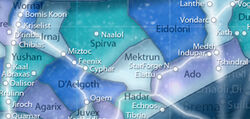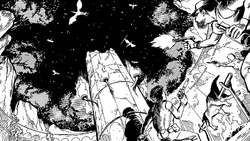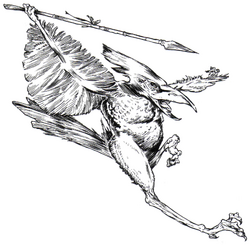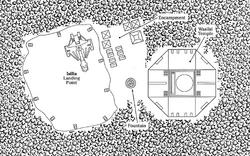Joralla was a jungle planet located in the Mid Rim's Mektrun sector. It orbited the red giant star Jaska and had an unstable climate that displayed considerable weather and seasonal changes. The planet's surface was divided between vast oceans and three main continents, whose terrain included high mountains, forests, and verdant jungles. The latter featured remarkably diverse plant life, including tequa bushes, sio trees, redspar fruits, and kewafi flowers. Various animal species also inhabited Joralla, such as the herbivorous oslets and the predatory wulkarsks.
The Tikiarri were a species of sentient bird that were tribal-based and highly aggressive. They frequently attempted to kill off-worlders in order to acquire advanced blaster weapons and were considered a menace in the neighboring star systems. At some point long before the Galactic Civil War, Joralla was home to another sentient species, the humanoid Wasilsi. They frequently engaged the Tikiarri in conflicts and eventually went extinct, leaving behind architectural ruins. The sentientologist Beyorth Gommdora theorized the Wasilsi originated off-planet and were eradicated by local bacteria or viruses. Joralla also occasionally received off-world visitors in the form of independent traders.
Around 3643 BBY, Joralla was placed under quarantine and blockaded due to an outbreak of a plague. Later, access to the planet was once again restricted under the authority of Moff Debin Seylas of the Galactic Empire due to the nearby systems experiencing troubles with the unruly Tikiarri. During the Galactic Civil War, the freighter captain Adriav Kavos arranged to sell a stolen Rebel Alliance data disk to a buyer on Joralla. A group of Rebel agents subsequently traveled to the planet in order to retrieve the data disk. The off-worlders were attacked by a tribe of Tikiarri before the buyer, an Imperial spy intent on double-crossing Kavos, arrived on Joralla as well.
Description[]
Astrography and atmosphere[]
Joralla was a terrestrial planet located in the Joralla system,[3] a part of the Mektrun sector[1] in the Western Reaches portion of[2] the Mid Rim.[1] The primary planet in the system[6] after which it was named, Joralla occupied the third and outermost orbital position around its sun, the red giant–type star Jaska, which bathed the planet in crimson light. Joralla had a rotational period of twenty-six standard hours, and its local year lasted 310 local days. The planet had standard gravity and had no moons.[3]
The atmosphere of Joralla was Type I, meaning it was well-suited for oxygen-breathing species. The planet's climate was dependent on its geographic latitude, being hot in the tropical and equatorial zones, cold in the northern and southern polar regions, and temperate in the areas situated between the two aforementioned regions. At the height of summer in the equatorial zones, the temperature could reach a peak of 50 degrees celsius, while in the polar regions, it could drop to a low of -35 degrees celsius during winter. Joralla's climate was also unstable, with abrupt changes from month to month caused by considerable weather and seasonal fluctuations. In the planet's jungle regions, rain occurred regularly.[3]
Geography[]

Joralla was a jungle planet located in the Mid Rim's Mektrun sector.
The majority of Joralla's surface was covered by rich oceans of deep blue water. The planet's land area featured three main continents. Joralla's western hemisphere had a single continent situated along the planet's tropical climate band yet also reaching the northern polar region. The eastern hemisphere's landmass was divided into two continents that both lay mostly in the tropical band, with the extreme northern and southern areas reaching into the planet's temperate regions. Four islands were also located between the two eastern continents.[3]
Joralla featured a diverse topography. The planet's main continents were covered with high mountain ranges that included both dormant and active volcanoes as well as immense waterfalls that cascaded from the mountaintops. Unimaginably powerful earthquakes had ripped chasms into the planet's bedrock, and those openings were being pummeled by the waterfalls. Elsewhere, rivers wound atop plateaus that were hundreds of kilometers in width. The planet had a moderate hydrosphere. Joralla also had potentially vast deposits of minerals,[3] and Jorallan opals[4] and Jorallan pearls were two types of gemstones found on the planet, with the latter specifically originating in its oceans[7] and the former being among the valuables circulating in the wider galaxy.[5]
A primarily arboreal planet, Joralla had vast forests located on the top of plateaus, and its continents also had cool forest regions. However, the planet's dominant terrain feature was lush, thick jungles that obscured the other landforms and were often too thick to traverse via speeder bikes and swoops. The jungle planet was a paradise world that was both dangerous and displayed an uncommon, savage beauty.[3]
Flora and fauna[]
Joralla's flora and fauna displayed remarkable diversity and beauty. The cooler forest regions of the planet were home to many similar species of plant and animal. In the jungles, the plant life was lush and colorful and featured thousands of fern, bush, and tree species. The latter two included the tequa bushes and the towering sio trees. Vines, striking flowers, and abundant amounts of vegetables and fruits also grew on Joralla, with the giant redspar fruit found almost anywhere on the planet. Many plants on Joralla possessed defense mechanisms, such as the ability to shoot poisonous barbs, as exhibited by the kewafi flowers.[3]
Joralla was home to a wealth of extremely varied animal species, specimens of which could have commanded high prices on other worlds. Jorallan animals, in combination with the local plant life, provided any visitors to the planet with a rich and varied diet. Many species of insect, mammal, bird, and reptile hid among the verdant plant life. Different varieties of wild game animals were present on Joralla, such as the timid, six-limbed arboreal herbivores known as oslets. The planet was also home to many predators. The wulkenso family included several closely related species of jungle and forest animals, of which the predatory wulkarsk was the largest member.[3]
The sentientologist Beyorth Gommdora hypothesized that the Wasilsi, a sentient species that at one point inhabited Joralla, were eradicated by a plague caused by local bacteria or viruses. Such microorganisms could have had survived on the planet until the time of the Galactic Civil War.[3]
History[]
A quarantined world[]
At some point around 3643 BBY,[8] a plague had broken out on Joralla. As a result, the planet was subjected to an official quarantine and blockaded by the reconstituted Sith Empire. An individual affiliated with one of the sides in the struggle ongoing at that time between the Galactic Republic and the Sith Empire sent a companion to run the blockade and deliver much-needed medicine to Joralla's inhabitants in order to win their support. The companion smuggled the medicine past the blockade, and the highly grateful citizens of the planet rewarded the individual in return.[9]
During the reign of the Galactic Empire, the star systems neighboring the Joralla system experienced problems with containing the unruly and aggressive nature of the Jorallan-native Tikiarri. On many nearby planets, any starship crew that mentioned it had visited Joralla had its vessel promptly searched for any members of the bothersome species, who were then either imprisoned or executed. Since the Empire refused to officially quarantine Joralla, Imperial Moff Debin Seylas had to appease the local systems by placing the planet under an unofficial quarantine and posting a regular patrol of the system, carried out by a pair of GAT-12 Skipray Blastboats.[3]
A rendezvous on Joralla[]
Adriav Kavos, the captain of the freighter Isilia, stole an important Rebel Alliance data disk while attacking a group of Rebel agents in the[3] Mektrun[1] sector during the Galactic Civil War. Kavos agreed to meet on Joralla an interested buyer—in reality, an Imperial spy planning not only to acquire the data disk, which was hidden in the modified stock of a blaster rifle, but also to capture the Isilia. The freighter traveled to the Joralla system without incident[3] but was forced to land[10] in a clearing in the Jorallan jungle adjacent to a ruined Wasilsi temple.[3]

A group of Tikiarri attack off-worlders in a ruined Wasilsi temple.
The Alliance sent a group of individuals to retrieve the data disk from Kavos. The Rebel agents arrived in the Joralla system late in the landing site's afternoon and, upon establishing contact with the Isilia's crew, posed as independent traders, allowing them to establish initially friendly relations. Late in the evening, a tribe of the local Tikiarri attacked the off-worlders, attempting to capture their blaster weaponry. The Imperial spy arrived early in the following morning, bringing along a complement of soldiers and summoning the Imperial Skipray Blastboats into the system.[3]
Inhabitants[]

The Tikiarri were a sentient species native to Joralla.
The Tikiarri were a sentient species of flying, carrion-eating bird native to Joralla. An estimated 10 million of the highly aggressive Tikiarri lived in unorganized tribes in the jungles of their homeworld. Ever since a careless trader introduced the Tikiarri to blaster technology, the natives made frequent attempts to acquire advanced weaponry by killing off-worlders. The dangerous nature of the avians led to an unofficial Imperial quarantine of their homeworld and its star system.[3]
At some point long before the Galactic Civil War, Joralla was inhabited by another sentient species, the humanoid Wasilsi. A religious people, the Wasilsi built permanent structures on the planet, utilized metalworking and a written language, and created numerous works of art. For many years, the Wasilsi were engaged in conflicts with the Tikiarri until the former eventually went extinct. The sentientologist Beyorth Gommdora theorized that the Wasilsi originated off-planet, either as colonists or the survivors of a starship crash-landing on Joralla.[3]
In addition to the native species, Joralla was occasionally visited by freighters of independent traders, despite the planet being nearly worthless economically. Those visitors resulted in a permanent planetary presence of no more than twenty Humans.[3]
Locations[]

One of the Wasilsi temples on Joralla
The extinct Wasilsi species inhabited villages and used religious temples, the ruins of which had become buried in Joralla's soil or overgrown by plants by the time of the Galactic Civil War. The remains of those structures featured artwork on walls that depicted battles between the Wasilsi and the Tikiarri.[3]
One of the Wasilsi temples was an octagonal structure located in the Jorallan jungle. In its center, the structure featured a domed space that had become exposed to the open sky upon the eventual degradation of the roof. The partial remains of a column, along with supports for torches, was located in the middle of the area. A fountain and a clearing with a landing field lay adjacent to the temple, as did the encampment of the freighter Isilia's crew.[3]
Behind the scenes[]
Joralla was first mentioned in Planets of the Galaxy, Volume One, a 1991 sourcebook for West End Games' Star Wars: The Roleplaying Game. The book presents an idea for a roleplaying game adventure that is set on Joralla. During the adventure, if the Tikiarri force is successful in its attack on the off-worlders, the natives can capture the blaster rifle with the data disk inside, further complicating the player-characters' mission. This article assumes the suggested scenario plays out as described.[11] The 2009 reference book The Essential Atlas placed the Joralla system, and therefore Joralla itself, in grid square L-17.[2] Joralla was subsequently mentioned in an Underworld Trading Crew Skill mission of the 2011 BioWare video game Star Wars: The Old Republic, though the information regarding the mission's outcome was later removed from the game.[9]
Appearances[]
- Star Wars: The Old Republic (Mentioned only)
Sources[]
- Planets of the Galaxy, Volume One (First mentioned)
- The Star Wars Planets Collection
- Alien Encounters
- The Complete Star Wars Encyclopedia
Notes and references[]
- ↑ 1.0 1.1 1.2 1.3 1.4 1.5
 Star Wars: The Essential Atlas Online Companion on StarWars.com (article) (backup link) — Based on corresponding data for Joralla system
Star Wars: The Essential Atlas Online Companion on StarWars.com (article) (backup link) — Based on corresponding data for Joralla system
- ↑ 2.0 2.1 2.2 The Essential Atlas — Based on corresponding data for Joralla system
- ↑ 3.00 3.01 3.02 3.03 3.04 3.05 3.06 3.07 3.08 3.09 3.10 3.11 3.12 3.13 3.14 3.15 3.16 3.17 3.18 3.19 3.20 3.21 3.22 3.23 3.24 3.25 3.26 3.27 3.28 3.29 3.30 3.31 3.32 3.33 3.34 3.35 3.36 3.37 3.38 3.39 3.40 3.41 3.42 3.43 3.44 3.45 3.46 3.47 3.48 3.49 3.50 3.51 3.52 3.53 3.54 3.55 3.56 3.57 3.58 3.59 The Star Wars Planets Collection
- ↑ 4.0 4.1 The Complete Star Wars Encyclopedia, Vol. II, p. 173 ("Jorallan opal")
- ↑ 5.0 5.1 Pirates & Privateers
- ↑ The Complete Star Wars Encyclopedia, Vol. II, p. 173 ("Joralla")
- ↑ The Complete Star Wars Encyclopedia, Vol. II, p. 173 ("Jorallan pearls")
- ↑ Per the reasoning here, Act I of Star Wars: The Old Republic takes place around 3643 BBY. Since players of The Old Republic can assign their companions on the mission "Blockade Run" independently of the main class storyline at any point during the game, the mission must take place at some point around 3643 BBY.
- ↑ 9.0 9.1
 Star Wars: The Old Republic — Underworld Trading Crew Skill mission: "Blockade Run"
Star Wars: The Old Republic — Underworld Trading Crew Skill mission: "Blockade Run"
- ↑ The Complete Star Wars Encyclopedia, Vol. II, p. 119 ("Isilia")
- ↑ Planets of the Galaxy, Volume One
